







FOOD: $185permonthforhealthyfood optionsformemberswithaqualifying chronichealthcondition
VISION: $300forprogressivelenses;upto $100peryearforadditionallenscoatings


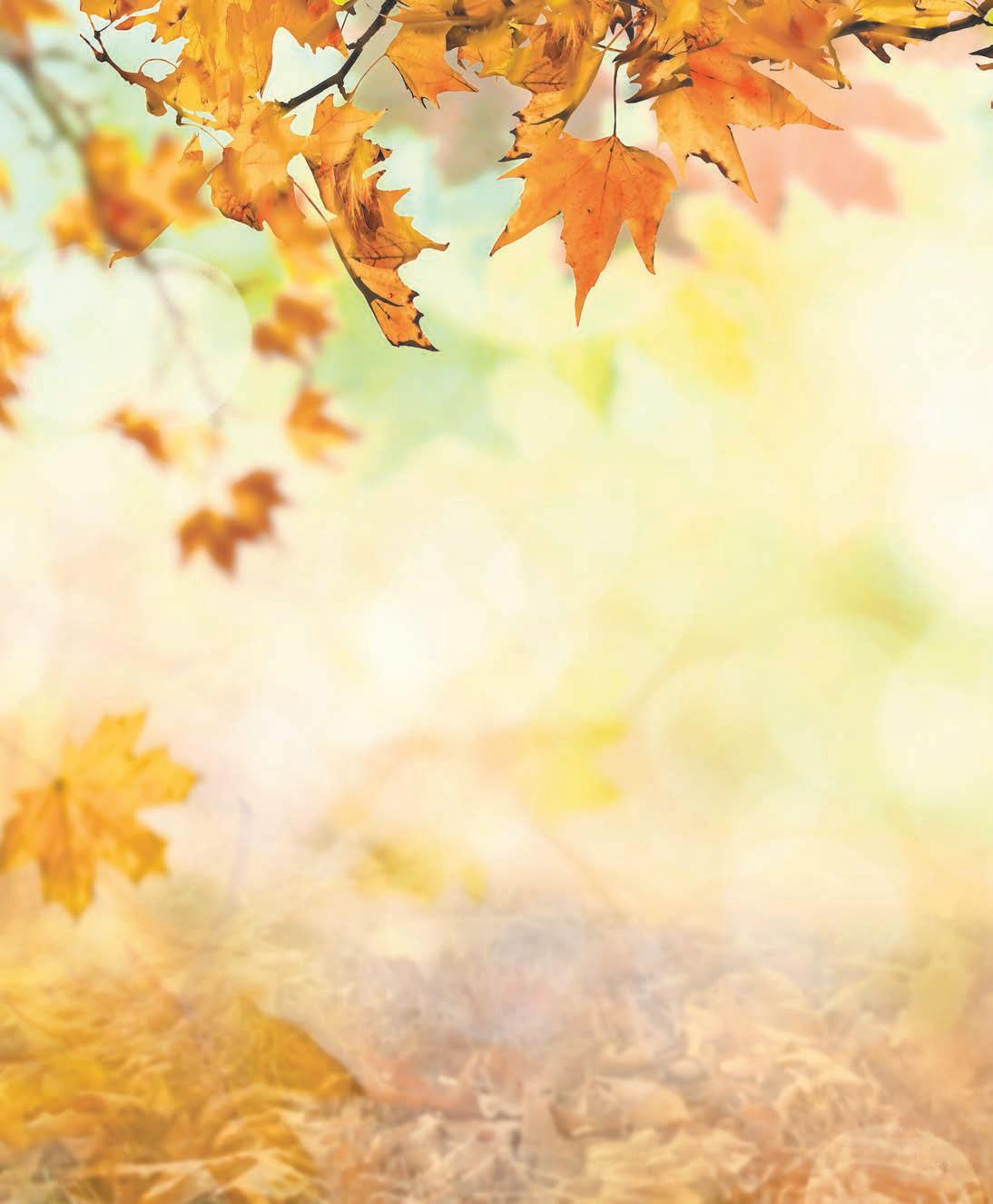


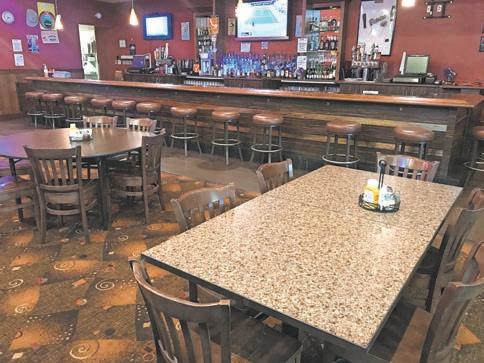




BEMIDJI PIONEER PUBLICATION
802 Paul Bunyan Dr. SE, Suite 19 Bemidji, MN 56601
218-333-9200
STAFF
Editor
Daltyn Lofstrom
Creative Director
Mollie Burlingame
Advertising Lindsay Nygren
Business Larisa Severson
ADMINISTRATION
Advertising Director Todd Keute
Editor
Annalise Braught
Controller Tammie Brooks
TO ADVERTISE
218-333-9200
James Hanson jhanson@bemidjipioneer.com
Questions and Feedback
Email inBemidji at inmagazine@bemidjipioneer.com
Volume 11, Issue 4
Copyright © 2024 Bemidji Pioneer in Bemidji
All rights reserved. Although some parts of this publication may be reproduced and reprinted, we require that prior permission be obtained.

ON THE COVER
Sarah Nassif instructs a participant on how to use the Saori Loon used to weave the dyed fibers as part of a community weaving water workshop.
Photo by Annalise Braught.

inBemidji’s mission is to be Bemidji’s and the surrounding area’s local lifestyle magazine. We strive to enhance the quality of life for the people of the Bemidji area by informing them about all of the amazing people who live in our community. Our concentration is on everything local: fashion, food, health, and most importantly, unique individuals and stories.
We strive to maintain a high level of integrity as an inspiring, local media presence for our readers and provide advertisers with a high-quality, effective marketing medium.
Read the award-winning inBemidji online!
Visit bemidjipioneer.com , then click on inBemidji near the bottom of the page.


A collaborative, ongoing art project brings together an entire community during the Watermark Art Festival.
Bemidji State’s Jim Karner uses his expertise to research meteorites in the frozen tundra of Antarctica.
Barry, Jeff and Logan Mitchell have kept soccer coaching in their family for 46 years.
Steak and taters are on the menu as Annalise serves up three different dishes for the fall issue of inBemidji.
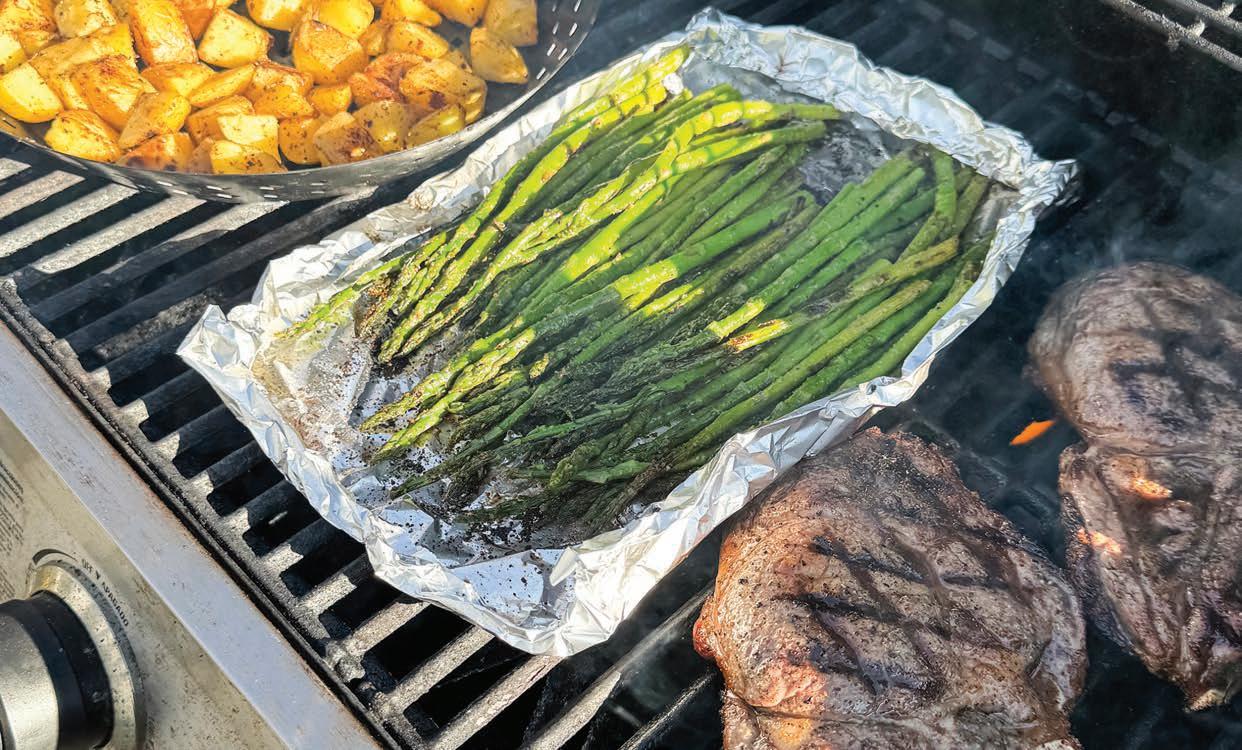

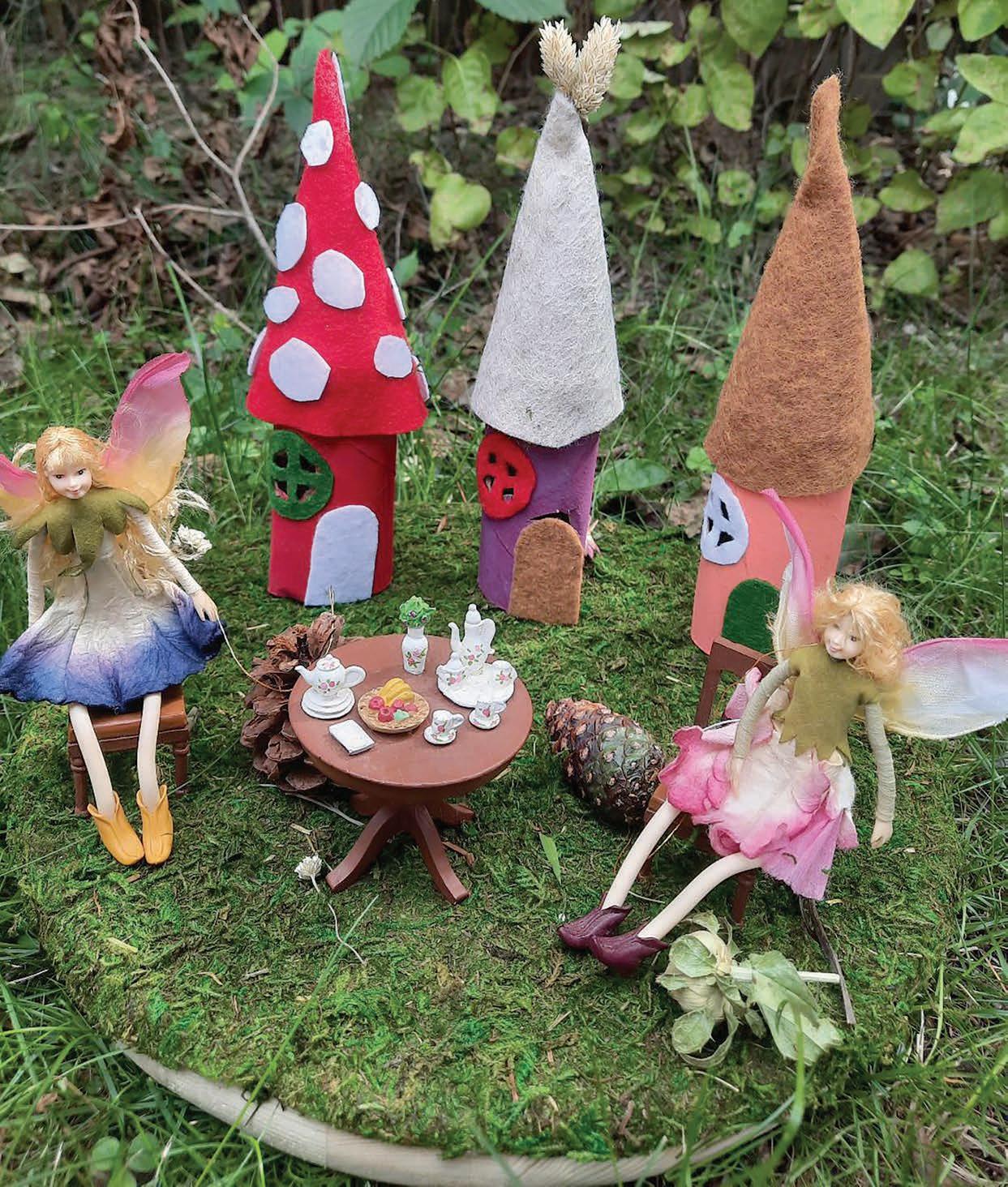


As autumn winds begin to blow and local creatures are getting ready to hibernate for the winter, these fun fairy houses offer an indoor version of a traditional fairy garden. Kids can get creative with their decorating and adults can add intricate details to these miniature homes. Try collecting and pressing dead or fallen natural materials like leaves, seasonal flowers and bark to add to this project.
• 3 toilet paper rolls • Felt sheets • Acrylic paint
• Scissors or craft knife
• Craft glue
• Paper
• Natural materials (optional)
Step One:
Paint toilet paper rolls. Let dry for 30-60 minutes or until dry to the touch.
Step Two:
Construct roofs by drawing three twodimensional cones on the felt. Draw a semicircle on the corner of a felt sheet and cut along the lines.





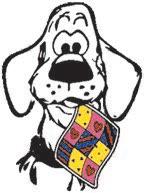



Apply glue to one straight edge of each roof.

Step Four:
Roll the roof into a three-dimensional cone, slightly overlapping the straight edges. Press firmly and hold for a few seconds to set the glue. Alternatively, you can staple the edges together.





Fine Art

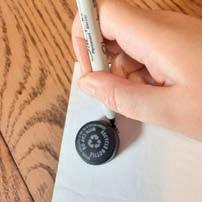
Step Five:
Ceramic & Candles

Gii Cards & Soap Photography

505 Bemidji Avenue N., Bemidji MN . 218-444-7570 WatermarkArtCenter.org

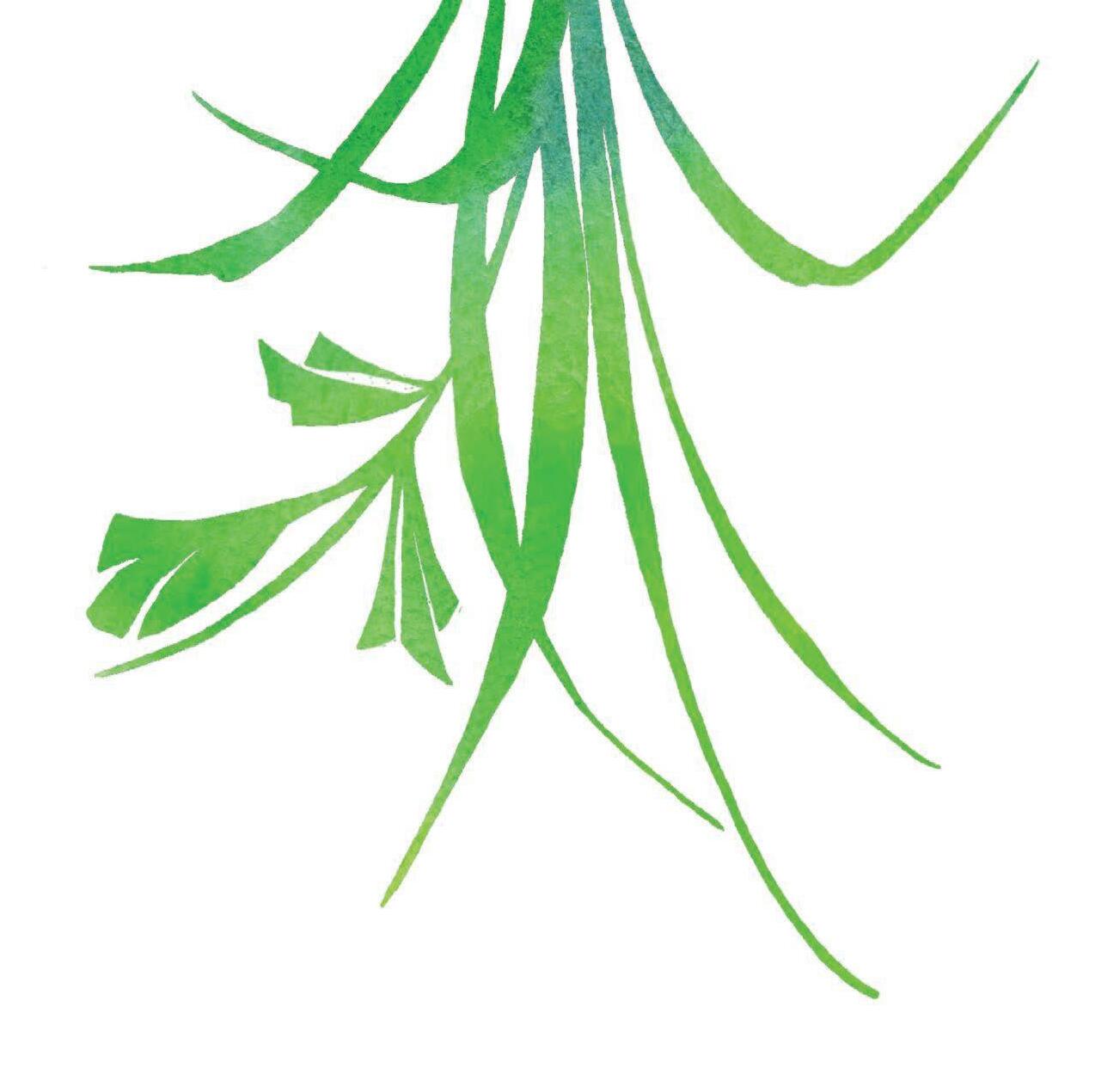
Draw doors, windows and other decorations on a sheet of paper to create a template. To make round windows, trace a bottle cap. For the mushroom roof, draw small spots.
Step Six:
Place the paper template over a felt sheet and use sharp scissors or a craft knife to cut out each piece. Adults should help children with this step.
Step Seven:
Glue a roof on the end of each toilet paper roll. To create the mushroom house, attach white felt spots to a red roof.
Step Eight:
Step Three: 3 4 5 6 7 8 9 10


LOCALLY OWNED & OPERATED
• Auto Parts
• Trailer Parts
• ANY Type of Battery
• ATV and RV Parts
Hours: Mon-Fri 7am-6pm • Sat 8am-1pm 710 Washington Ave S, Bemidji • (218) 751-3838



Paste doors onto the fairy houses. To make an open door, cut the cardboard along the door’s edge until you reach the top of the door.
Step Nine:
Place felt windows on the side of the houses and trace around them. Cut the shape of the windows out, leaving a small border of cardboard inside the marked line.
Step Ten:
Glue windows to the cardboard border. Add any other decorations to the walls and roof, such as flowers, leaves or twigs.


Vaccinesareyourchild’sbest defenseagainstsomeofthe mostdangerousdiseases. Duringawellchildvisit,your child’sprimarycareprovider canensuretheyaregetting theimmunizationstheyneed tostayprotected.

ScheduleawellchildvisittodayonMySanford Chartorbycallingyourchild’sprovider.



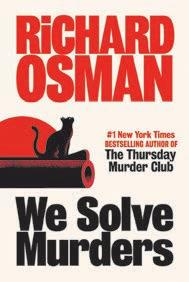


With the renewed fall season comes a selection of new books for the fall issue of inBemidj. Four Pines Bookstore of Bemidji selected a range of titles with something for everybody.
The Mighty Red By Louise Erdrich
The Book Swap By Tessa Bickers
Somewhere Beyond the Sea By TJ
Klune
We Solve Murders By Richard
Osman
What We Sacrifice for Magic By
Andrea Jo DeWerd







Weaving Water Workshop fosters community through art


As attendees milled about the 56th Annual Watermark Art Festival in July, some took the opportunity to become artists themselves.
Amidst clotheslines of indigo-dyed fabric pieces from prior participants, others contribute to a community art project focused on the connective nature of water and spirit of collaboration.
Such a project is called the “Weaving Water Workshop –Landscape of Creativity,” part of an ongoing process kickstarted by Minneapolis-based artist Sarah Nassif in 2018.
“My background is in botany and environmental education, and I design projects and experiences that help people connect to nature and help organizations connect with new audiences,” Sarah explained.
Jill Newman, art education program director for Watermark Art Center, played an integral role in Nassif’s presence at the Watermark Art Festival as she helped secure a grant from the Region 2 Arts Council thanks to a legislative appropriation from the Arts and Cultural Heritage Fund and with support, in part, from First National Bank Bemidji and Bemidji Area Arts Endowment.
Sarah’s project was funded alongside two others: Tammy Nara’s Paint and Hike Workshops, and Sonja Larsen’s Printmaking Demo and Participation Day at Watermark Art Center – further deepening the depth of the center’s artistic offerings.
“The overarching focus is to bring in artists that have a connection with art and nature and how that can bring our community together,” Jill noted.
“We also wanted to include artists that would serve multi-generational populations. With Sarah’s project, we’ve worked with people of all ages, which has been really awesome.”

Revisit your childhood and discover the “Antiques Capital of The North” Explore a vast array of treasures in our 7,000 sq. ft. store!
“The overarching focus is to bring in artists that have a connection with art and nature and how that can bring our community together.” - Jill Newman
What may be considered an unconventional approach to art, Sarah has long focused on the process rather than the final product.
“I work as a social practice artist. In other words, I’m not coming in to produce something specific or teach a certain way of doing anything,” Sarah said. “I’m here to facilitate connections and to curate a way to create a community setting where people can converse with each other and experiment with creative techniques.”
Festival-goers had a chance to quell their curiosities of the Weaving Water Workshop as they began the first step of the process. Selecting a strip of cloth, attendees could write down a body of water that was special to them.
Among a vast variety of lakes, rivers, ponds and streams, perhaps the most distant aquatic body derived from the Northern Italian unicycle team in town for Unicon 21 – the world unicycling championships and convention – coinciding with the Watermark Art Festival. The workshop transcended international boundaries with Italian lakes being represented on cloth and transferred onto paper that will be incorporated into the final artwork.
“These were posted on a bulletin board and seeing all the different lake names, thinking about how many connections we have just as people interacting with nature, we shed a light on that,” Sarah said.
The next step involved clamping the cloth with clothes pins or rubber bands and wetting the fiber in water from Lake Bemidji.



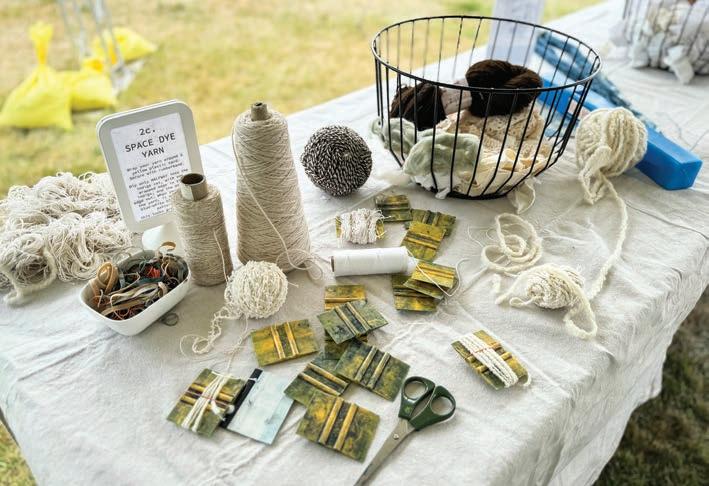
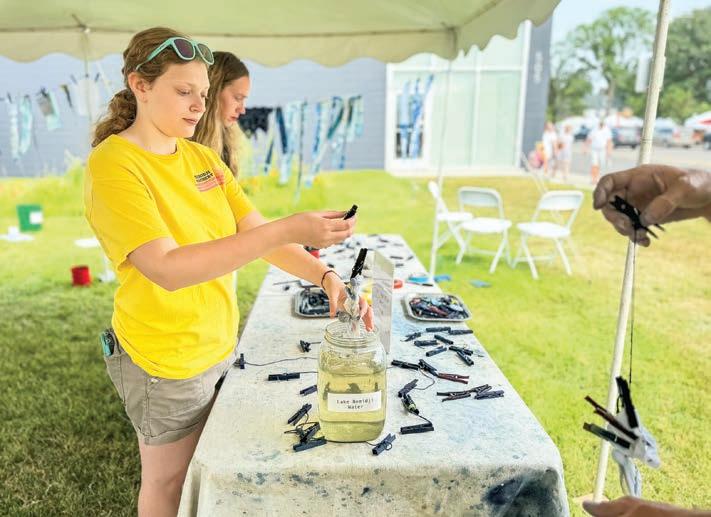


“We had a jar that said ‘Lake Bemidji water’ on it,” Sarah added. “It was a fun way to really create a physical connection with the lake.”
Once wettened, participants dipped their bundles in vats of organic indigo –local to the Bemidji area.
Blue-and-white splotched cloth hung out to dry as the process continued.
“It created this sort of working textile studio where people were welcome to stay for five minutes or stay for two hours,” Sarah mentioned.
The final step involved weaving pieces together on a floor loom, creating a blueand-white textile that measured around seven meters long as of the end of July. A large piece of fabric incorporating everyone’s strip of cloth and their connection to water will be transformed into a sculpture to be displayed at the Watermark Art Center later this year.
For Jill, the opportunity to encompass the Northwoods in Sarah’s Weaving Water Workshop proved beneficial for all sides of the artistic coin.
“This is something that Sarah has done repeatedly, but this time it was tailored to Watermark Art Center,” Jill said. “We have been working together on this since February, so it’s been very special for us, as well. We feel a strong connection to the project because we’ve been able to have this wonderful partnership with Sarah.”
Sarah commended Jill and the Watermark Art Center for their partnership throughout the process –however unconventional it may have been.
“I’m less interested in self-promotion and more interested in functionally providing something that lifts more boats than my own,” Sarah said. “A lot of the art world is set up for you to create your fantastic idea and then exhibit it, end of story. Trying to shift the situation toward this collaboration with the organization, toward the project itself being an on-thefly collaboration with the participants is a less common way of working.
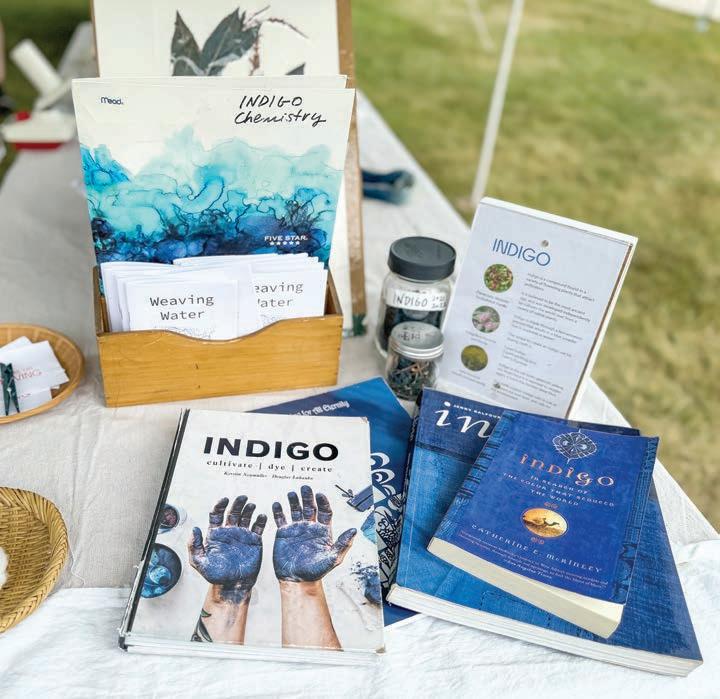























“It takes a really special partner to be able to pull that off successfully and to feel the support from that organization is really critical for me to be successful in putting the project together. All of those things were Watermark; they came with glowing reviews from other artists and friends that have worked with them.”
Beyond the Weaving Water Workshop, Jill noted WAC’s commitment to broadening its class offerings moving into the future. Doing so will be one way to encourage more community members to realize their own artistic inclinations, a notion that is already underway because of indigo and Lake Bemidji water.
“We used to be more fine art-focused, but now we’ve expanded to more artisan classes where people are able to create things that they can use and feel successful in creating those things,” Jill said. “You don’t have to be a watercolorist to be able to take a class at Watermark. You can be an everyday person and we want to extend that welcome to everyone.
“The community-building piece is a really big part of this. We’re here to make something together.” ■







Jim Karner stands and searches for meteorites in gravel wind deposits in Antarctica.
Contributed / Jim Karner
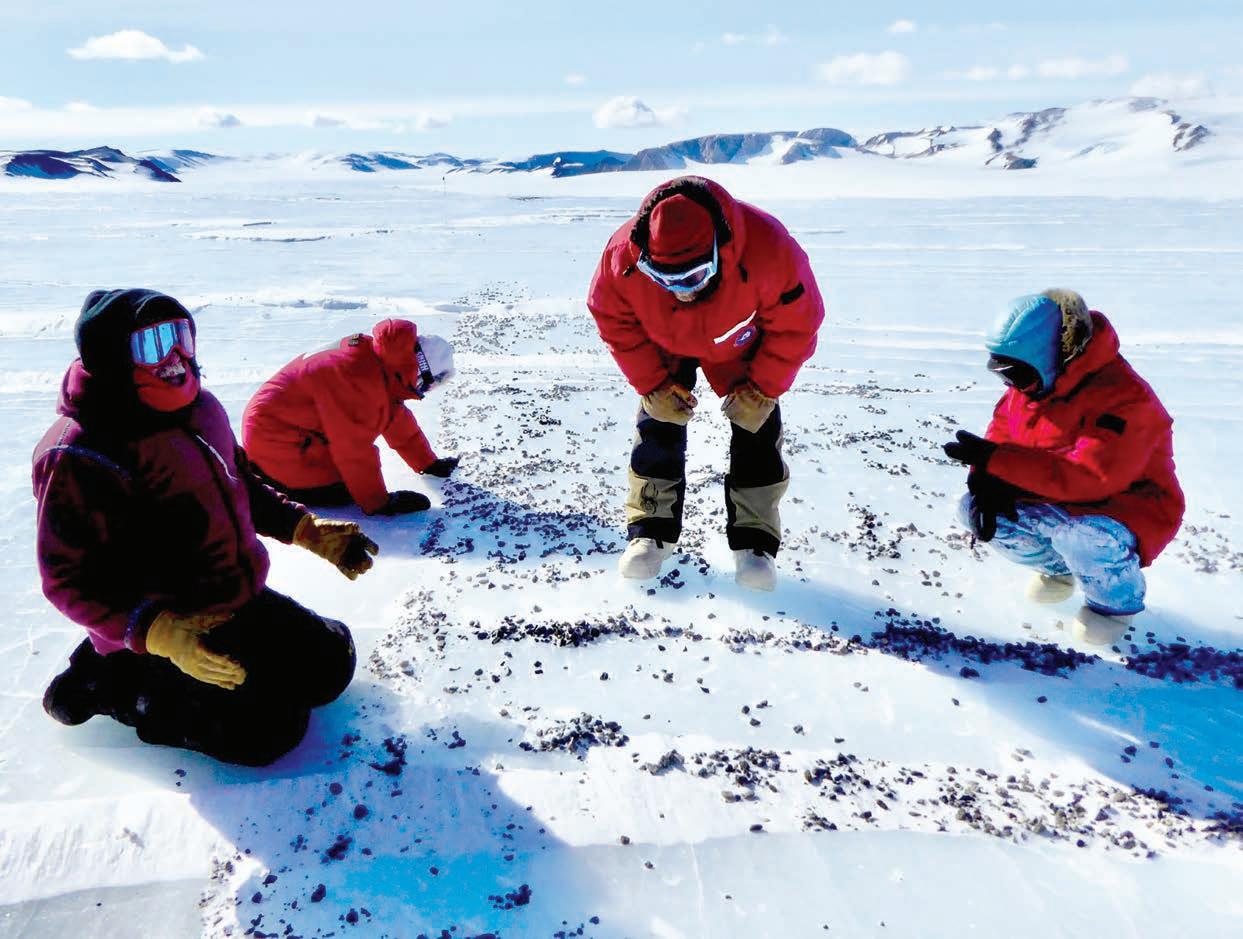
by Stella Dolan special to inBemidji
Not many Beavers are ever spotted in Antarctica. But Dr. Jim Karner’s groundbreaking advancements in the frozen tundra are certainly hard to miss.
Karner, a 1994 graduate of Bemidji State University, is well-accustomed to cold environments from his days playing college hockey throughout the frigid winters of Bemidji. And ever since, he has seamlessly transitioned his expertise to meteorite research on the icy continent of Antarctica.
“Being from Grand Forks and going to Bemidji State, I think those are a couple of the coldest places in the U.S.,” Karner said. “I grew up playing hockey, so I was used to skating outside, being in the cold,
temperatures below zero. I was ready for that, and I had experienced that kind of cold, but a lot of the people on these trips have never experienced cold before.”
In 2009, Karner seized an opportunity to join the Antarctic Search for Meteorites program, a pivotal moment that marked the beginning of his leadership in Antarctic scientific expeditions.
Each December, Karner and his team venture by small aircraft into the Transantarctic Mountains in Antarctica, enduring extreme cold and challenging conditions to find meteorites.
“Once we are out in the field, we’re there for five or six weeks. We live
in tents and we’re 250 miles away from any type of building or person or anything else,” said Karner. “We search in these spots called blue ice areas where old glacial ice is at the surface. That’s where meteorites that have been contained in the ice for hundreds of thousands of years are exposed at the surface.”
One of Karner’s greatest findings occurred during the team’s third visit to this specific field in 2019 when he discovered a small piece of a lunar meteorite. The rock had a glossy black exterior and a distinctive fusion crust. Inside, the rock revealed a composition of black basalt and white anorthosite, similar to the moon’s surface.


Karner knew immediately: “This was a piece of the moon.”
Karner compared the rock to a “miniature full moon.” The rare find not only exemplified Karner’s mastery but also highlighted the significance of Antarctic expeditions in advancing planetary science.
“There are only a couple hundred pieces of the moon that have ever been found on earth,” Karner said. “It was such a beautiful specimen. I had never seen a lunar meteorite in the field before.”
Northern roots, southern success
Karner’s landmark discovery in Antarctica was the culmination of a journey that largely began at Bemidji State. During his undergraduate years from 199094, he was a key member of BSU’s men’s hockey team and contributed
to its 1994 national championship. Still today, Karner emphasizes the various life lessons he learned on the ice of the John S. Glas Fieldhouse.
“When you’re from northern Minnesota or North Dakota, you’re instilled with this hard work,” Karner said. “The effort you learn about growing up in the North, it’s what will set you up for success, in any program really, and academics was the same way.”
The values Karner learned at Bemidji State have profoundly influenced his approach to research and leadership, equipping him to confront challenges and inspire others. Now a research professor at the University of Utah, Karner teaches these same lessons to his students.
He often emphasizes the enduring impact of his BSU education, advising students to uphold a strong work ethic and consistently “show up.” These principles, ingrained during his time at
BSU, have steered Karner’s pursuit of knowledge and exploration throughout his career.
After earning his bachelor’s degree, Karner pursued graduate research at the University of New Mexico, guided by his northern Minnesota connections. His BSU geology professor, John Annexstad — a Walker native — was the former associate curator for lunar samples for NASA’s Apollo Space Program who also led the creation of the Antarctic Search for Meteorites program.
Annextad introduced Karner to Jim Papike, then the director of the Institute of Meteoritics at the University of New Mexico.
Papike, a former resident of Eveleth, Minn., profoundly influenced Karner’s professional career at UNM. Working with Papike and Annexstad provided Karner with invaluable mentorship and opportunities, shaping his expertise in planetary geology and meteorite research.
Bemidji State named Karner an Outstanding Alumni in 2012, recognizing his dedication to planetary geology and Antarctic research. This award honored his significant impact on scientific exploration and commitment to advancing knowledge in his field. Karner considers this recognition, alongside his role as head of the meteorite research program, among his proudest career achievements.
Karner’s experiences serve as a testament to BSU’s role in encouraging ambition and empowering students to pursue their dreams with determination. Karner’s transition from Bemidji State’s hockey rinks to the expansive Antarctic ice showcases how his northern resilience and academic background have driven his success, embodying the spirit of a true Beaver pioneering in scientific explorations.
“If you look at people involved in college athletics, especially from BSU, they often find success in life because they learn teamwork and achievement,” Karner said. ■

- Dr. Jim Karner





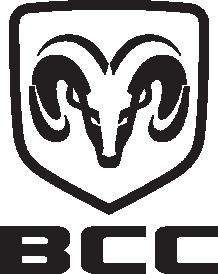







Compassionisatthecenterofwhatwedo.Ourmultidisciplinaryteamsupports youandyourfamilybeyondtreatmenttoensureyoufeelseen,heardand safeateverystepofyourbreastcancerjourney.
SpecialtiesandservicesinBemidji:
•Geneticcounseling
•Medicaloncology
•Nursenavigation
•Palliativecare
•Radiationoncology
•Survivorshipservices
Visitedith.sanfordhealth.orgto learnmoreaboutbreastcancer servicesinBemidji.

1IN8WOMEN willbediagnosed withbreastcancer intheirlifetime.
Awomanisdiagnosed withbreastcancer EVERY2MINUTES. Anestimated 310,720cases ofbreastcancer arediagnosedin womeneveryyear.
Mostbreastcancers arediagnosedinwomen AGES50OROLDER .
Regularmammogramscancatchbreast cancerearly,atitsmosttreatable stage.Ourbreastradiologists,certified mammographersandgeneticcounselors allworktogetherwithonegoalinmind–protectingyourbreasthealth.
Mostwomenshouldstartannual screeningsatage40.Ifyou’reduefor ascreening,scheduleamammogram throughMySanfordChartorbycalling yourclinic.
Ifyou’reunder40yearsoldbuthavea familyhistoryofbreastcancer,talkto yourprimarycareprovideraboutwhen tostartscreening.
HowoftenshouldIgetamammogram? Detectingbreastcancerearlycanmakeit easiertotreat.That’swhyallwomenages 40andoldershouldgetscreenedatleast onceayear.
Howlongdomammogramstake?
Mammogramappointmentsarequick. Yourappointmentwilltypicallytakeless than25minutes.
Aremammogramsfree?
Manyinsuranceproviderscoverscreening mammograms,butit’sbesttocheckyour plantoconfirmyourcoverage.


Getting organized can be as simple as taking small steps that have lasting impact.
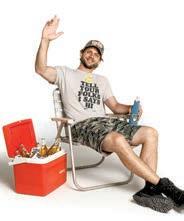

Metro Creative Connection
There are plenty of things that can use a little organizational attention. There's no ideal way to get organized. Whatever works is a good approach, but the following are six strategies to help individuals clear the clutter.
1. Utilize to-do lists
People tend to be less productive when they're storing all of their tasks in their brains. The first step to getting organized is to remove those plans from the head and put them down on paper or in some other tracking tool. A digital to-do list manager, for example, enables you to see all of your tasks, deadlines and due dates in one place so you can get things done more efficiently. Carry around a notepad or use the digital notes app on a phone to jot down thoughts and needs as they come up.
2. Corral your "smalls"
Smalls are keys, phones, chargers, wallets, headphones, and other accessories. When these items are grouped together, they're easier to find so you can stay on track. Invest in an attractive organizer and install it by the front door or another hightraffic area. You'll cut down on trying to find those smaller items when running errands.

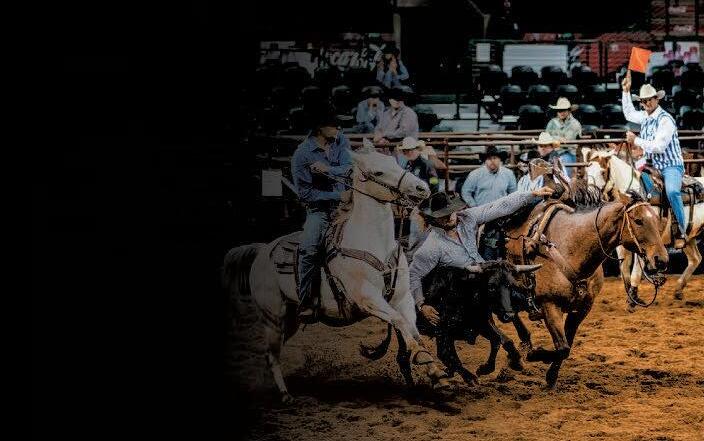



3. Conquer clutter regularly
It's easy to be put off by cleaning and organizing when clutter has gotten out of control. Instead, by cleaning up items on a daily or weekly basis, it's much easier to keep ahead of clutter. Treat it like a daily job, including sorting mail and tossing unnecessary items; emptying waste pails; dusting the desk; deleting emails; and putting items back where they belong.
4. Categorize emails
Utilize the folder creation option from popular email providers to sort your messages. Drop messages that need attention into categories of your choosing, such as school, health and receipts. Then you'll know which folder to go into when searching for what you need, eliminating the time-consuming task of scrolling through a full inbox.
5. Give one; toss one

When bringing new items into the home, follow the procedure of giving away or throwing out one item for each new item that is received or purchased. This can help to tame clutter.

6. Mise en place your life
"Mise en place" is French for "put in place." It is used in the kitchen to refer to preparing and setting out all ingredients needed in a recipe. The same concept can be used elsewhere. Lay out clothing on the

dresser for the next day at work or school. Prep the foyer of a home with items you need, like an umbrella, shoes and paperwork. Organize backpacks so they're ready for the school day. Establish a to-go bag at work for items that need to be brought home. ■
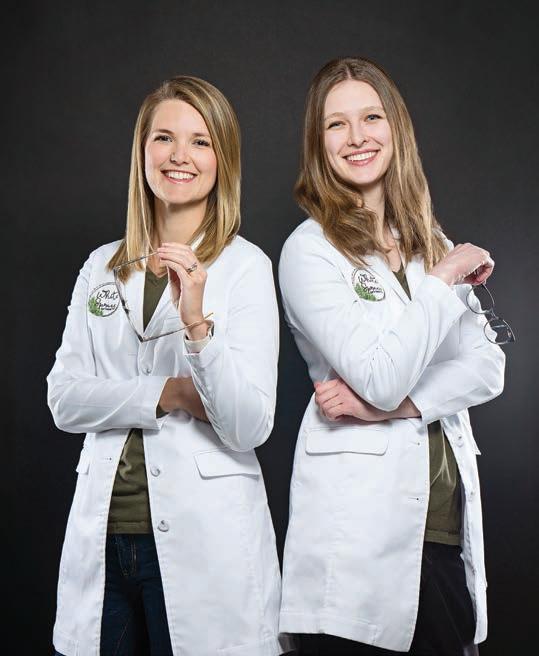


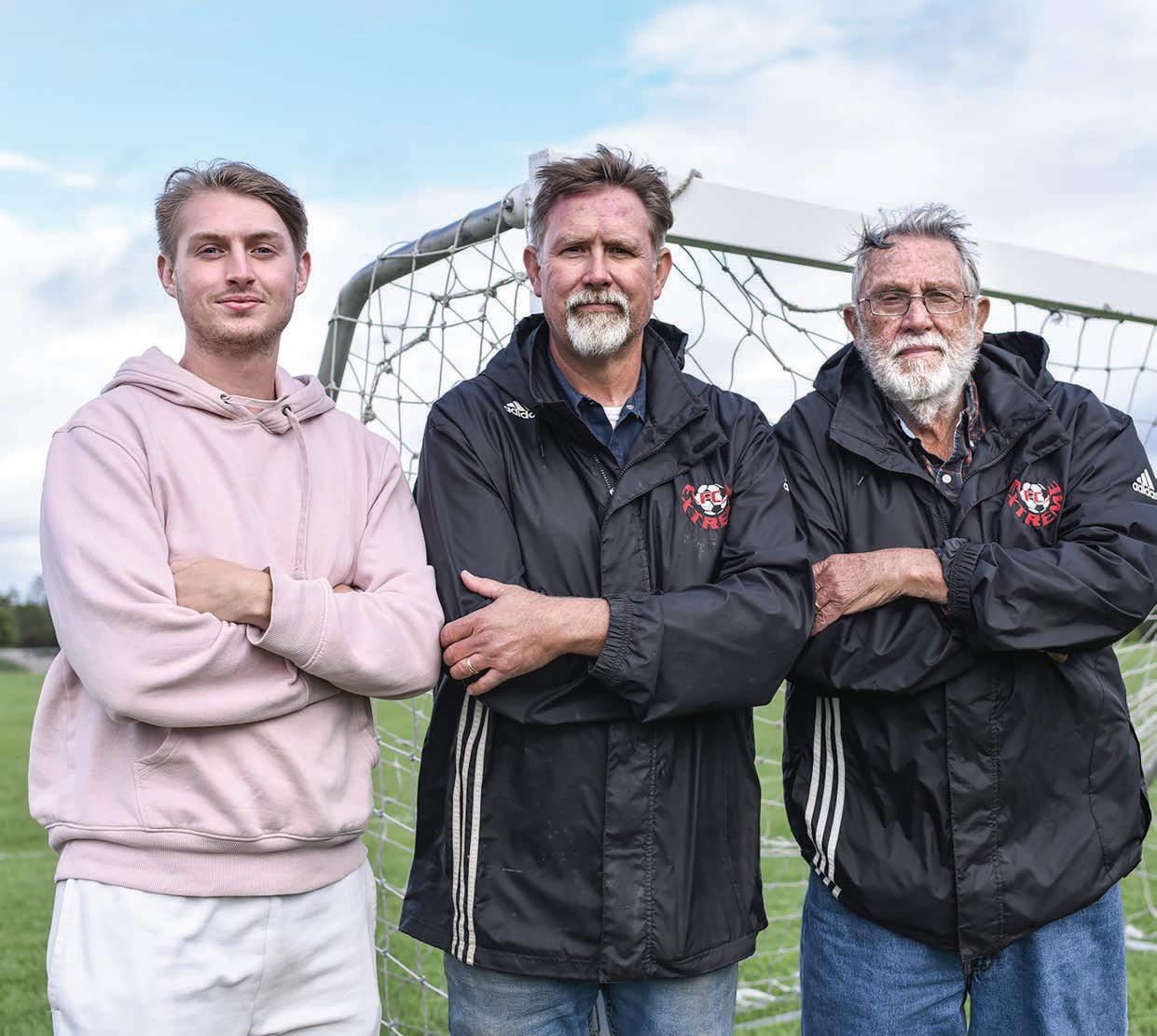
by Jared Rubado inBemidji staff
Barry Mitchell returned from a business trip to his home just outside of Tulsa, Okla., in 1978. His wife, Marlene, was waiting with a surprise.
“After I got home, she told me what she’d done,” Barry recalled.
While Barry was away for work, Marlene received the news that one of her sons was on the verge of seeing his summer soccer team disbanded. They didn’t have a coach. Without hesitation, Marlene volunteered Barry’s services.
“I had absolutely no idea what soccer was or how to coach it – not a clue,” Barry said with a laugh. “Our middle son wasn’t going to get to play. There were 10 other kids that weren’t going to have a team to play on because of it. Not that I had a choice, but we went from there.”
Barry didn’t know he was signing up for a 46-year commitment. It was the summer that kickstarted a coaching career and strengthened his family’s love for soccer.
As time wore on, Barry refined his craft. His son, Jeff, followed in his footsteps. Now, Jeff’s son, Logan, is following in his.
But instead of building a threegeneration coaching legacy in the South, the Mitchell family landed in Bemidji.
“(We) vacationed up here, and it just sucked us in I guess,” Jeff said. “I brought my wife up here, and she liked it. So when we got done with college, we made a pros and cons list and decided to give it a whirl up here. We probably won’t ever leave.”
Jeff moved to Bemidji in 1999, and his soccer-crazed mentality pushed him to get involved at the youth level. He approached longtime Bemidji High School boys head coach Rick Toward with an idea to rejuvenate youth soccer, creating a more competitive lane for thousands of underutilized athletes.
“(Bemidji) had youth soccer going through Community Education at the time for the little kids,” Jeff said. “Most of the (coaches) they had out there were football players, baseball players. A lot of them had never played soccer. It kind of changed when I started talking to Rick. We wanted to bring that program under the Bemidji Youth Soccer Association, and it’s just continued to grow.”
When the revamp happened 25 years ago, it started with roughly 150 kids. Now, over 500 players, either playing competitively or recreationally from ages 4-19, play in the Bemidji Youth Soccer Association – one of the area’s most prominent youth athletic programs.

And at any given practice, scrimmage or tournament, you’ll likely see a Mitchell family member on the sideline.
Barry, 85, hasn’t given up coaching. Jeff, 52, serves as a coach and the program’s club administrator. And now, Logan, 22 – a product of the program –is paying it forward as a coach.
“It’s a sport I love, and I just want to see it keep growing in Bemidji,” Logan said. “I hope it gets bigger and bigger because we still need some of the recognition we don’t have being from a smaller town in northern Minnesota. I don’t think my dad and Rick could’ve picked a better place to get a big program up and running. I’m so extremely thankful for everything they do for the community.”
When Jeff and his wife moved to Bemidji, they didn’t have kids to place in the youth program. It proved to be a bit of a hurdle for getting involved in youth soccer.
“When I came up here, I tried to get on the board of directors,” Jeff said. “They wouldn’t let me because I didn’t have a kid playing, which was a rule at the time. I got on the board the next year, and I’ve been on it for 24 years now.”







“Part of why Bemidji soccer is so successful at the high school level is because of the seamless transition from youth to the school program.”
- Rick Toward

Long after Jeff got a handle on things, Barry made the move up from Oklahoma. He and Marlene settled in Bemidji 12 years ago. His itch to coach soccer traveled with him.
“For the longest time, I never knew that he didn’t actually play and only got into coaching when my dad was younger,” Logan said of Barry. “Seeing him do that, and then eventually getting to coach with him and seeing how he coaches and what he knows without ever playing the game himself, it’s honestly extraordinary. The things he knows and how he can get kids to progress, it’s remarkable.”
Through each stage in the latter half of his life, Barry kept coaching. He stuck with it after moving to Minnesota, then again after his wife died in 2021. For Barry, soccer has been a rewarding cornerstone.
“It’s the kids,” Barry said. “I hear people my age talk about the younger generation. They say it’s going to hell in a handbasket. That’s because they don’t know them. These kids are great.”
By the time Barry got settled into Bemidji, his grandsons, Logan and Cole, were middle school-level players.
“I think I was 3 years old when they first brought me out here and I started doing rec soccer,” Logan said. “Ever since then, I just stuck with it and kept playing. My first soccer memories are kicking the ball around with my dad and my grandpa. I’ve been at these fields my whole life.”
Logan had a standout high school career with the Lumberjacks, helping BHS to state tournament appearances in 2017 and 2018 before graduating in 2020.


Bemidji's U19 boys soccer team won the Greater Grand Forks Tournament. Pictured members include (front row from left): Coach Rick Toward, Charlie Zellmann, Lincoln Schmitt, Ben Frauenholtz, Connor Helm, Al Toward, Brady Riley, Noah Meyer Nick Rautio. Back row: Jacob Stanoch, Jonathan Devescovi, Thomas Harris, Brodie Price, Reed Johnson, Isaac Stone, Noah Johnson and coach Jeff Mitchell. Contributed
The Bemidji Youth Soccer 19U boys team took first place at a recent tournament in Grand Forks, N.D. Pictured in the front row, from left, are Brodie Price, Max Harris, Noah Johnson, Reed Johnson and coach Logan Mitchell. In the back row are Jacob Stanoch, Tommy DeGeus, Bo Hofstad, Will Greendahl, John McNallan, Isaac Stone, Connor Helm, Thomas Harris, Thomas Paquette, Nick Rautio, Abraham Bratlien, Jonathan Devescovi and coach Barry Mitchell. Contributed
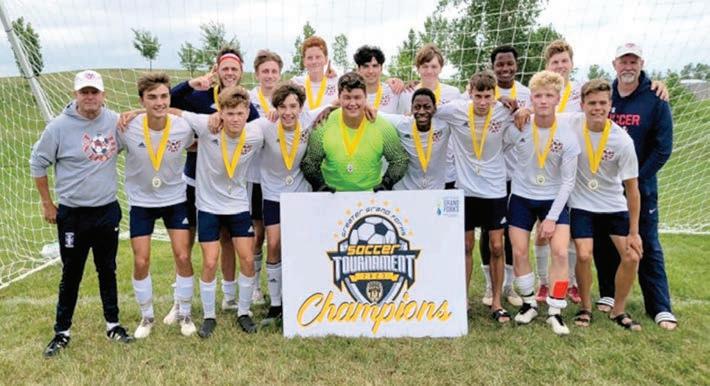





“When I was younger, I never really thought about (coaching).”
- Logan Mitchell
However, Logan didn’t necessarily see himself extending the Mitchell family coaching tree.
“When I was younger, I never really thought about (coaching),” Logan said. “Once I got to high school, I started coaching the rec kids here, and I enjoyed it. But even doing that, I never really thought I’d start coaching (beyond that). But I’m really glad I did.”
Together, the Mitchells all work toward the same goal, regardless of what level they’re coaching. They instruct with an emphasis on development, serving as a feeder program to the high school teams from the ground up.
But more importantly, they aim to give kids positive, life-building experiences.
“Part of why Bemidji soccer is so successful at the high school level is because of the seamless transition from youth to the school program,” Rick said. “It’s the same voice from when they start until they’re 19 years old. It may come out of a different mouth, but it’s the same voice. It’s the same song, and that’s largely driven by what Jeff sees as a way to teach and play the game.”





Over the course of 25 years, Jeff has seen a competitive bump across the board. Players at each level are further developed than they were before the program was revamped in large part due to the continuity through coaching.
“(The competitiveness) is higher now than it was 25 years ago, and hopefully, it’ll get better, too,” Jeff said. “The struggle we have is we don’t have multiple options for kids. We don’t have a separate competitive program. If you know you’re going to make a team, you don’t have to (give) 100% to make it. We want to get to a point where kids are pushing and being pushed for (roster) spots.”
Despite the lack of competitive avenues for youth players beyond what the Bemidji Youth Soccer Association currently has to offer, Bemidji still plays at a higher level than towns of similar population. Rick, who’s entering his 30th year coaching the Lumberjacks, is reaping the developmental awards in Section 8-3A.
“Look at the towns similar to our size like Detroit Lakes and Crookston. We’d still be one of those
kinds of programs competitively if Jeff didn’t show up.
“Now, we beat Moorhead, we beat Brainerd, we beat (St. Cloud) Tech. We sent the U19 boys to four tournaments this summer, and they were in the championship game in all four of them, winning two of them and losing the other two in (penalty kicks). We’re playing at a high level, and a lot of it has to do with those three Mitchells.”
But what each Mitchell coach had to learn was the ability to adjust their expectations and approach for different age groups. Jeff and Barry got an understanding of that when they coached in Oklahoma, and Logan is learning as he gets deeper into coaching.
“I needed to learn the nurturing side of it,” Jeff said. “When you look at that aspect with a younger age group, you want them to compete, but you also want them to do their very best. We’re not trying to put the super team out there – a team of 8, 9-year-olds who are the fastest and most athletic. We want to teach kids the game and help them develop. We want them to learn the game.”
Jeff expects to have a fourth Mitchell on the pitch next summer
when his oldest son, Cole, rejoins the youth soccer program. For Jeff, the youthful injection into the Bemidji youth soccer coaching scene is needed.
“At some point in time, my dad will be done coaching, and so will I, and so will Rick,” Jeff said. “We need those guys like my sons Logan and Cole coming up doing this stuff. We need guys like (BHS girls soccer head coach) Logan Larsen, or Rick’s daughter Harper (Toward). We need that next generation to come through and continue this. I’m just so happy two of my kids want to do it.”
But above all else, the Mitchells are thankful to be in it together.
“Seeing my son, my grandson out here, it makes me so proud,” Barry said. “It makes me go to tears. They’re the people that you’ve gotten to see grow in the sport over time. Now they’re paying it forward to the next generations. … I always mention this (to the players), what we coach doesn’t just pertain to soccer. This is life. These are lessons you learn in soccer that you take with you as you get older. That’s very rewarding to me. It keeps me young.” ■









As we head into the thick of harvest season, Annalise is helping out in Larisa’s kitchen for this issue of inBemidji to offer some delicious dishes featuring steak, taters and other garden veggies. Hopefully these recipes will offer you a few tasty reasons to use up all that extra garden produce in some creative ways this fall!
INGREDIENTS:
2 steaks of choice
1 package asparagus
1 pound Yukon gold potatoes
Butter
Olive oil
Steak seasoning
Salt, pepper, garlic and onion powder
INSTRUCTIONS:
Steak: Pat steaks dry and coat lightly with olive oil before seasoning them with your seasoning of choice. We used Aldi’s steak seasoning blend along with some extra salt and pepper.
Prep potatoes: The best way to get perfect potatoes on the grill is to parboil them first to ensure an even cook and speed things up a bit. Yukons have thin skin, so they do not need to be peeled. Just dice into about three-quarter inch cubes. Place cubes in a medium-sized pot, cover with water, add about a half teaspoon of salt to the water and let boil. Once potatoes are slightly soft to the touch but not all the way cooked through — about 8 to 10 minutes — remove from heat and drain water. Put the potatoes in a bowl, coat with olive oil and season with salt, pepper, garlic and onion powder. Pour into a grilling basket if you have one. Otherwise, you can place them in tin foil to grill.
Asparagus: Wash and cut the bottom portion of the stems off, just leaving the tender top portion. Coat with oil and season with salt, pepper, garlic and onion powder, and place on a grill mat if you have one or tin foil.
Grilling time: With everything prepped, it should all be able to go on the grill at the same time and be done within 10 minutes depending on your grill’s heat and your preferred cook on the steaks. Keep stirring your veggies to ensure they are cooked evenly. Once everything is tender and the steak is done to your liking, remove from heat, plate and eat up!

INGREDIENTS:
2 steaks of choice
1 tablespoon butter
2 cloves garlic
1 shallot
1 cup baby bella mushrooms
1 cup cherry tomatoes
3/4 cup chicken stock
1/2 cup heavy cream
1/2 lemon, juiced
1/2 cup fresh grated parmesan cheese
1-2 sprigs of fresh rosemary and thyme
Salt, pepper and garlic powder to taste
INSTRUCTIONS:
Prep: Dice up the shallots, mince garlic, wash and thinly slice mushrooms, wash cherry tomatoes and herbs.
Steak: Season steaks with salt, pepper and garlic powder then sear them on medium-high heat in some olive oil. Once your steaks have a nice crust, remove from heat and let rest.
Veggies: In the same pan, add the garlic, shallots, mushrooms, whole cherry tomatoes and some butter. Then add sprigs of rosemary and thyme. Stir and let simmer until veggies seem close to done, about 5-8 minutes.
Add chicken stock, then stir in heavy cream, lemon juice and fresh parmesan.
Slice steak against the grain and add it to the pan. Spoon the sauce over the steak. Plate it all up and enjoy!







Sun-Thur: 11am-9pm | Fri & Sat: 11am-9:30pm Lunch: Mon-Fri: 11am-4pm












ExpertService • Local&OrganicProduce
BulkFoods&Herbs • AffordablePrices
FullServiceDeli • Organic&FairTradeCoffees
PlantBasedProteins • SpecialtyCheeses
Organic,Nitrate&AntibioticFreeMeats • &MORE!
302IrvineAvenueNW,Bemidji,MN56601•218-751-2009•harmonyfoods.coop
Bemidji’sDowntownFull-ServiceGroceryStore&Deli

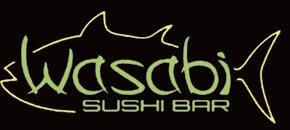

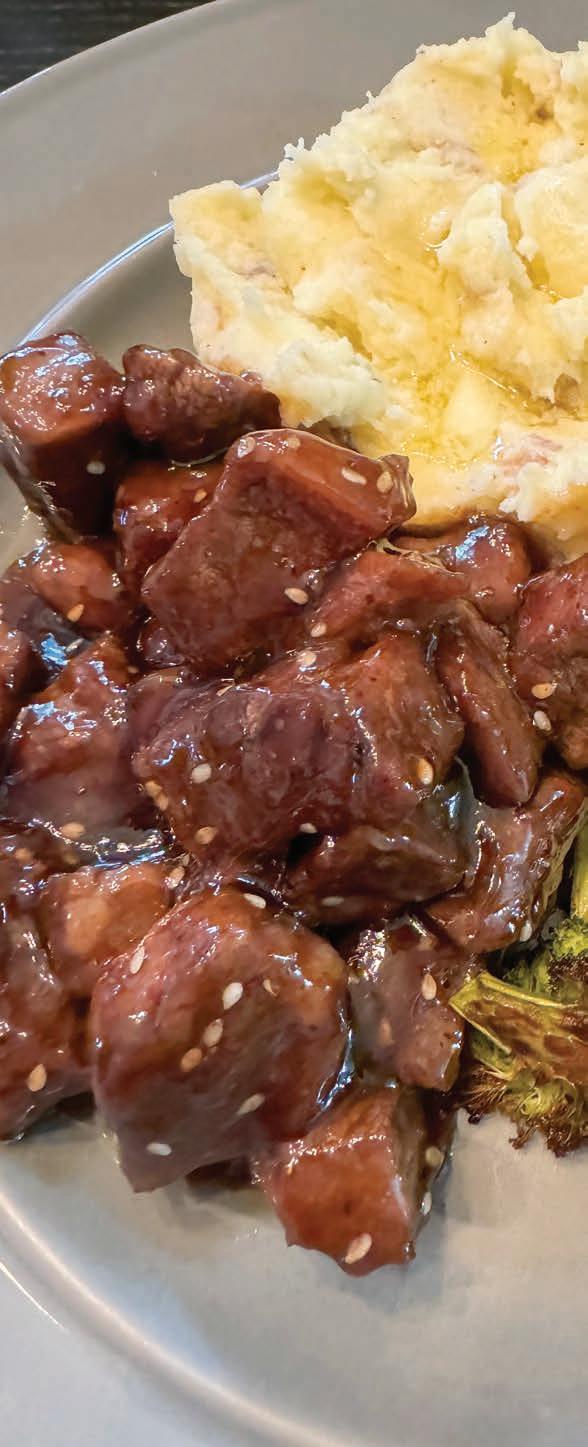

INGREDIENTS:
2 steaks of choice
2 small broccoli heads
1 pound Yukon gold potatoes
1 thumb fresh ginger
1 tablespoon sesame seeds
4 tablespoons sour cream
3 tablespoons butter
1 teaspoon wasabi paste
½ cup teriyaki sauce
INSTRUCTIONS:
Prep: Adjust rack to top position and preheat oven to 425 degrees. Wash and dry all produce. Cut broccoli florets into bite-size pieces, if necessary. Dice potatoes into ½-inch pieces. Peel and mince or grate ginger.
Roast broccoli: Toss broccoli on a baking sheet with a large drizzle of olive oil, salt and pepper. Roast on top rack until tender and browned at edges, around 15-20 minutes.
Mashed potatoes: Place potatoes in a medium pot with enough salted water to cover. Boil until tender, 15-20 minutes. Once potatoes are tender, reserve ½ cup potato cooking liquid, then drain and return potatoes to pot. Add sour cream, 3 tablespoons butter and wasabi paste to taste. Mash until smooth, adding splashes of reserved potato cooking liquid as needed. Season with salt and pepper. Cover to keep warm.
Cook steak: Pat steak dry with paper towels. Season generously with salt and pepper. Heat a large drizzle of oil in pan, add steak and cook to desired doneness, 3-6 minutes per side. Turn off heat; transfer to a cutting board to rest. If there’s excess grease in your pan, carefully pour it out.
Sauce it up: In the same pan used for steak, add 1 tablespoon butter, sesame seeds and as much ginger as you like. Cook until fragrant while stirring, 1-2 minutes. Stir in any resting juices from steak. Add teriyaki sauce; bring to a simmer. Turn off heat.
Plating: Divide potatoes and broccoli between plates. Slice steak against the grain; arrange over potatoes. Spoon sauce over steak. Top with as many extra sesame seeds as you like.











by Jennifer Koski special to inBemidji
Name: Monica Hansmeyer
Age: 54
Occupation: Artisan jeweler
Where we found her: At a fundraiser
+ Are you originally from Bemidji? No, I grew up in Long Prairie on a dairy farm with 13 siblings. I like having a big family – and I feel lucky to have been brought up on a dairy farm.
+ Why is that? There’s a unique experience of having your income come from a farm. Our farm was 250 acres, so my family grew everything that the cows needed. We produced alfalfa and hay, so we had to bale hay. We produced oats and corn. We had a garden. It was a lot of work, and when my parents retired from farming, my dad took over the garden.
A farmer and a farmer’s wife don’t just retire and sit around. They need things to do. They are used to work, and they were hard workers.
+ Did that work ethic rub off on you? 100%. Oh yeah, it did. My work ethic is: You quit when the job is done. But I’m also going to say that none of us siblings decided to farm, because we also had a real curiosity and a love of travel and experience that a farm life just can’t give. My siblings were excellent examples of curious travelers. And I’m not talking about all-inclusive travel; I’m talking travel. I had a sister who lived on a sailboat for 10 years — and traveled back and forth from South America. A brother who traveled through the United States and Colombia, studying agriculture. One sister became a travel nurse after raising her three kids.
My older brothers took off and traveled on motorcycles across the United States and hitchhiked in Europe. I think it was somehow in our blood.
+That’s inspiring. My siblings did not give me advice. They just showed me by example that travel was important – and how beneficial it is to learn and be curious about the world. I’d see them come back and tell stories.
My sister Dorothea lived in Ecuador for two years. Just recently,
I found a letter she wrote me then, and it was quite profound about how to live life.
+ How did you become a jeweler? I attended three separate universities, all for art. I started at Bemidji State University and spent a year and a quarter there. Then I transferred to Stout University in Wisconsin, and by the luck of it all, the painting class was full so they put me in a jewelry class. I took that jewelry class and I loved it. They just had a great art program at Stout – it was so good.
+ How did you land there? Just because someone in my dorm had a dad who taught there, and said they had a good art program. So I thought, “Oh, I’ll go there!” The third school was University of Minnesota-Duluth.
+ Why did you leave Stout? Well, I had met someone — my now-husband Mark — at Bemidji State when I went to school there, and we remained dating long distance when I transferred to Stout. I had decided to travel to Oaxaca, Mexico, that summer and Mark went on a 60- or 70-day sea kayak trip with his friends. Once we got back from those trips, we knew we wanted to be at the same school. We missed each other. So we both transferred to Duluth.

ReStore is a building supply thrift store that sells new and gently used home improvement materials and home furnishings to support Habitat’s construction and affordable mortgage program.
How does ReStore work?
Donate Materials
Donate surplus or gently used materials. Your donation will conserve waste in landfills, eliminate disposal fees and may earn you a tax deduction.
Shop
When it’s time for your own home improvement project, check the ReStore first. It’s a gold mine for bargain hunters!
Volunteer
+ I can never let a “how did you meet” opportunity pass by. So tell me: How did you first meet Mark? We met through the Outdoor Program Center at Bemidji State. I went on a spring break trip when I was a freshman that he was on, too. He was so cute.
+ So you graduated from Duluth? That is not where I graduated from. I stayed for a year and a half, and then I got wanderlust and I took out a student loan and traveled to Guatemala. It was amazing and I had awesome adventures. But Mark and I were lovesick! So he sold his sea kayak and we traveled together for the last two months.
So I did graduate eventually, but we held off. We got back from Guatemala and we stayed in Minnesota for a while, then there was an opportunity to lead 30-day wilderness trips for adjudicated youth on the East Coast. We did one year’s worth of work at this organization. It was a perfect place for 20-somethings from all over the country to work.
+ It sounds pretty spectacular. Then Mark and I finally got married, and we moved to Montana. And while we were in Montana, we thought, “Why don’t we finish our degrees?” So we came back to Bemidji and worked at the Outdoor Program Center and finished our degrees

NO boxmattresses, rummage,clothing,springs,exercise equipment

Whether you have a few hours a week or just one day per year, ReStore needs you – we have a multitude of tasks to fit your schedule.
ReStore Proceeds go toward building Habitat for Humanity homes in Beltrami and Clearwater Counties.
Donate Tues 10-2; Wed-Fri 10-4:30; Sat 9-12:30
Shop Wed-Fri 10-5; Sat 9-1
218-444-6398 restore@northwoodshabitat.org | 1357 Exchange Ave SE, Bemidji









in our late 20s. Bemidji State had an excellent BFA program that I hopped right into.
They even had jewelry — and an instructor who taught jewelry etching, which was a game changer for me. I had an excellent internship with a jewelry designer in the warehouse district of Minneapolis for almost a year. That’s where I built my skills, my designs. And it’s where I realized I can have this career. I can make jewelry and send it to galleries and stores because that’s what this designer did. And I just knew it was an attainable thing.
+ And the rest is history? I honed my skills working part-time for a local jeweler for two years, and learned a lot while building my own designs. And I’ve now been a self-employed jeweler for 24 years. It’s my full-time occupation. I have a line of
jewelry and I sell that to stores and galleries and through my website, sevensisterdesign. com. I also do custom work for people, like wedding rings and mother’s jewelry. And I do one or two art fairs a year.
+ 5 things you love? My family, swimming at sunset when the water’s orange and your eyes are at water level and the loons are calling, making jewelry, having and watching others experience moments of awe and laughing.
+ Perfect Saturday? I would wake up on a canoe trip in Canada on a big puffy white cloud, blue sky August day with my family. We’d have a long, beautiful day of portaging and canoeing — and swimming throughout the day – and then we’d get to an amazing campsite, cook over a fire, watch a sunset and swim more. And we’d pick blueberries. That would be an amazing day.


+ Biggest adventure? This one is going to be tough. I’ve had a lot of big adventures, but the most formative adventure was traveling alone in Oaxaca when I was 20. I met a group of single travelers from all over.
There was an archeologist, a dancer from San Francisco, a teacher from Chicago, a local guy named Jesus and some expatriates. And they took the young one, me, on these adventures with them. I got to watch the eclipse from Monte Albán because of my archeology friend who was along. It was amazing.
+ That sounds like a life-changing experience. After that, I’d say my biggest adventure was climbing Pingora Towers in the Wind Rivers in Wyoming with Mark. Or quitting our jobs at age 30 and traveling in Alaska.
+ You have sons. What do you want for them? To be curious. To travel. And to meet a lot of people because they set you on different paths. ■

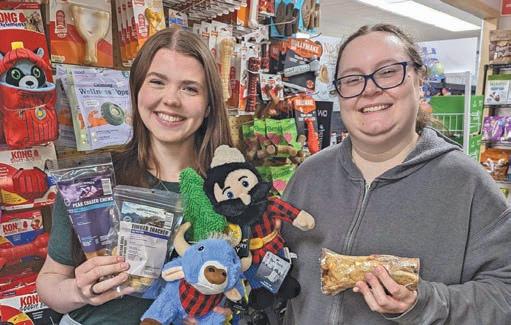
• Experienced and caring
•


the pet lover!


Yards strewn with pumpkins, ghouls and other festive decorations are a sure sign of a spooky season. Can you spot 6 differences between these two photos from last Halloween?
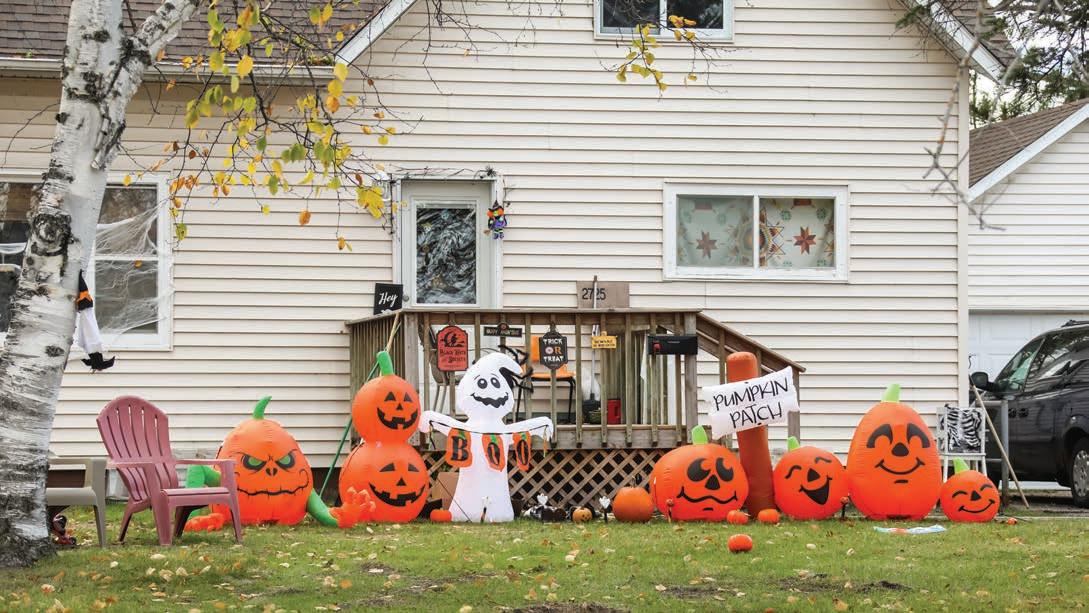








• Mail, office and school paper
• Magazines and catalogs
• Newspaper and inserts
• Phonebooks


• Cardboard
• Cereal and cracker boxes
• Shoe boxes, gift boxes, electronics boxes
• Empty Water, soda and juice bottles
• Milk bottles
• Ketchup and condiment bottles
• Dishwashing and detergent bottles
• Shampoo, soap, and lotion bottles
• Yogurt, pudding and fruit cups
• Margarine, cottage cheese and other containers
• Produce, deli and take out containers
• Food and beverage bottle and jars
